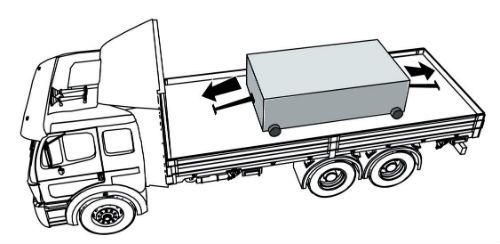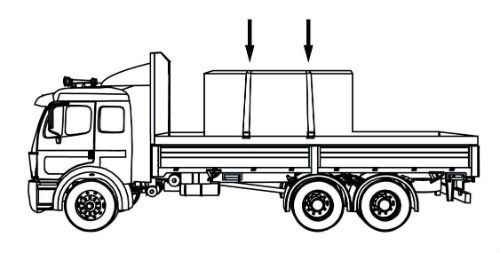CDL Practice Tests: Flatbed Cargo Securement
Choose A Section:
Go!Cargo securement for a load weighing 37,000 lbs must be able to withstand a minimum forward braking force of:
- 18,500 lbs
- 29,600 lbs
- 10,000 lbs
- 7,400 lbs
How well must the securement system work? (Section 1.3)
Each cargo securement system must be able to withstand a minimum amount of force in each direction.
- Forward Force = 80% of cargo weight when braking while driving straight ahead.
- Rearward Force = 50% of cargo weight when accelerating, shifting gears while climbing a hill, or braking in reverse.
- Sideways Force = 50% of cargo weight when turning, changing lanes, or braking while turning.
-
Upward Force = 20% of cargo weight when traveling over bumps in the road or cresting a hill.
- This requirement is satisfied when the cargo is "Fully Contained."
Define 'bolster':
- A crosswise load bearing structural component, particularly a part of a log bunk.
- An inflatable bag intended to fill otherwise empty space between articles of cargo, or between articles of cargo and the wall of the vehicle.
- A structure, device, or another substantial article placed against or around an article to prevent horizontal movement of the article.
- A vertical barrier across the front of the deck of a vehicle to prevent forward movement of cargo.
Bolster:
A crosswise load bearing structural component, particularly a part of a log bunk.
What is a cab shield?
- A vertical barrier placed directly behind the cab of a tractor to protect the cab in the event cargo should shift forward.
- The depression formed between two cylindrical articles when they are laid with their eyes horizontal and parallel against each other.
- A vertical barrier across the front of the deck of a vehicle to prevent forward movement of cargo.
- A structure, device, or another substantial article placed against or around an article to prevent horizontal movement of the article.
A sided vehicle containing cargo weighing 35,980 lbs must be able to withstand a rearward force of at least:
- 28,784 lbs
- 36,000 lbs
- 17,990 lbs
- 10,000 lbs
Note: If the cargo is contained in a sided vehicle, the vehicle structure MUST be strong enough to withstand the forces described earlier.
- Forward force: 0.8 g (80%)
- Rearward force: 0.5.g (50%)
- Sideways force: 0.5 g (50%)
Option #3 for securing metal coils transported with eyes lengthwise includes all of the following except:
- Using blocking or friction mats to prevent forward movement.
- Attaching at least one tiedown over the top of the coil near the rear of the coil.
- Attaching at least one tiedown over the top of the coil near the front of the coil.
- Attaching at least two tiedowns through the center of the coil.
Tiedowns, Single Coil Option #3
Option #3 is the same as Options #1 and #2, except that the two tiedowns that attach through the eye of the coil are replaced with two tiedowns that pass over the front and the rear of the coil.

Attach at least one tiedown over the top of the coil near the front of the coil.
Attach at least one tiedown over the top of the coil near the rear of the coil.
Use blocking or friction mats to prevent forward movement.
Requirements for securing heavy vehicles, equipment, and machinery apply at what weight?
- 50% the weight of the trailer
- More than 10,000 lbs
- Less than 10,000 lbs
- More than 4,500 lbs
What Does This Section Cover?
The requirements in this section apply to the transportation of heavy vehicles, equipment, and machinery that:
- Operate on wheels or tracks, such as front end loaders, bulldozers, tractors, and power shovels.
- Individually weigh more than 4500 kg (10,000 lb.).
When securing paper rolls with eyes vertical in a sided vehicle all of the following are acceptable except:
- Placing rolls against the doors.
- Placing the rolls against each other.
- Placing rolls against the front and walls of the vehicle.
- Placing the rolls against other cargo.
- Place paper rolls together in a group so that the structure of the group can be maintained.
- Place paper rolls against:
- The front and walls of the vehicle
- Each other
- Other cargo
If the cargo is fully contained in a sided vehicle, what is the minimum requirement for withstanding sideways force?
- 0.5g (50% of cargo weight)
- 0.2g (20% of cargo weight)
- 0.8g (80% of cargo weight)
- 0.7g (70% of cargo weight)
Note: If the cargo is contained in a sided vehicle, the vehicle structure MUST be strong enough to withstand the forces described earlier.
- Forward force: 0.8 g (80%)
- Rearward force: 0.5.g (50%)
- Sideways force: 0.5 g (50%)
When securing paper rolls with friction mats as a primary method:
- The friction mat should stick out from underneath the roll in the opposite direction for which it is providing securement.
- The friction mat should stick out from underneath the roll in the direction it is providing securement.
- All of these answers.
- Make sure friction mats are completely covered by the roll.
Requirements for friction mats

If a friction mat is used to provide the principal securement for a paper roll, insert the friction mat so that it sticks out from beneath the footprint of the roll in the direction in which it is providing securement.
As part of the log packing requirements:
- Each inside log on the side of a stack of logs must touch at least two bunks, bolsters, stakes, or standards.
- Outer bottom logs must be in contact with and rest solidly against bunks, bolsters, stakes, or standards.
- Logs must be loosely packed.
- The center of the highest log on each side or end must be above the top of each stake, bunk, or standard.
Packing requirements
- Logs must be solidly packed.
- Outer bottom logs must be in contact with and rest solidly against bunks, bolsters, stakes, or standards.
-
Each outside log on the side of a stack of logs must touch at least two bunks, bolsters, stakes, or standards. If one end of the log doesn't touch a stake:
- It must rest on other logs in a stable manner.
- It must extend beyond the stake, bunk, bolster, or standard.
- The center of the highest log on each side or end must be below the top of each stake, bunk, or standard.
About The Flatbed Cargo Securement CDL Manual
Studying the flatbed cargo securement CDL manual is not a requirement for getting your CDL permit or license. It is required knowledge for flatbed drivers.
Some questions you should be able to answer for flatbed cargo securement:
- What is the minimum Working Load Limit of a tiedown used to secure logs?
- What is the minimum weight of a shipment of paper rolls that would require specific securement requirements?
- When securing concrete pipe over 45 inches loaded crosswise, which direction must the tiedowns on the front half of the load run?
- What is a cab shield?
- When securing concrete pipe over 45 inches loaded crosswise, which direction must the tiedowns on the rear half of the load run?
- What is a dunnage bag?
- Who is responsible for inspecting securing devices and cargo within the first 50 miles?
- How many tiedowns are required on a stack of shortwood loaded crosswise?
- What is the minimum working load limit of each tiedown used to secure crushed or flattened vehicles?
- Define 'bolster'
- What is a hook-lift container?
- When a tiedown is attached directly to the cargo, what is the ideal angle where it attached to the vehicle?
What is a securing device?
Any device specifically manufactured to attach or secure cargo to a vehicle or trailer:
- Synthetic Webbing
- Chain
- Wire rope
- Manila rope
- Synthetic rope
- Steel strapping
- Clamps and latches
- Blocking
- Front-end structure
- Grab hooks
- Binders
- Shackles
- Winches
- Stake pockets
- D-rings
- Webbing ratchet
- Bracing
- Friction mat
What is a tiedown?
A combination of securing devices that forms an assembly that:
- Attaches cargo to, or restrains cargo on a vehicle.
- Is attached to anchor point(s).

Some tiedowns are attached to the cargo and provide direct resistance to restrain the cargo from movement.

Some tie-downs pass over or through the cargo. They create a downward force that increases the effect of friction between the cargo and the deck. This friction restrains the cargo.
 Related Cargo Securement Terms That Every Driver Should Know:
Related Cargo Securement Terms That Every Driver Should Know:
-
Tiedown:
A combination of securing devices which form an assembly that attaches cargo to, or restrains cargo on, a vehicle or trailer, and is attached to anchor point(s).
-
Contained:
Cargo is contained if it fills a sided vehicle, and every article is in contact with or sufficiently close to a wall or other articles so that it cannot shift or tip if those other articles are also unable to shift or tip.
-
Blocking:
A structure, device, or another substantial article placed against or around an article to prevent horizontal movement of the article.
How should tiedowns be attached?
Tiedowns can be used in two ways:
-
Attached to the cargo:
- Tiedowns attached to the vehicle and attached to the cargo.
- Tiedowns attached to the vehicle, pass through or aroundan article of cargo, and then are attached to the vehicle again.
-
Pass over the cargo:
- Tiedowns attached to the vehicle, passed over the cargo, and then attached to the vehicle again.
Tiedown placement:

Place the tiedown as close as possible to the spacer.
Position the tiedowns as symetrically as possible over the length of the article.

Position the tiedowns to preserve the integrity of the article.







 TT On Facebook
TT On Facebook